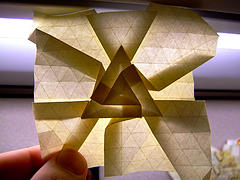
Origami
The Japanese art of paper folding is obviously geometrical in nature.
Some origami masters have looked at constructing geometric figures such
as regular polyhedra from paper. In the other direction, some people have
begun using computers to help fold more traditional origami
designs. This idea works best for tree-like structures, which can be
formed by laying out the tree onto a paper square so that the vertices
are well separated from each other, allowing room to fold up the
remaining paper away from the tree. Bern and Hayes (SODA 1996) asked,
given a pattern of creases on a square piece of paper, whether one can
find a way of folding the paper along those creases to form a flat
origami shape; they showed this to be NP-complete. Related theoretical
questions include how many different ways a given pattern of creases
can be folded, whether folding a flat polygon from a square always
decreases the perimeter, and whether it is always possible to fold a
square piece of paper so that it forms (a small copy of) a given flat
polygon.
- Krystyna Burczyk's Origami Gallery - regular polyhedra.
- The business card Menger
sponge project. Jeannine Mosely wants to build a fractal cube out of
66048 business cards. The MIT Origami Club has already made a smaller version of the same shape.
- Cardahedra.
Business card polyhedral origami.
- Cranes, planes, and cuckoo clocks.
Announcement for a talk on mathematical origami by Robert Lang.
- Crumpling
paper: states of an inextensible sheet.
- Cut-the-knot logo.
With a proof of the origami-folklore that this folded-flat overhand
knot forms a regular pentagon.
- Einstein's origami
snowflake game. Rick Nordal challenges folders to make a sequence of geometric
shapes with a single sheet of origami paper as quickly as possible.
- Escher's
buildings in origami.
- Folding
geometry. Wheaton college course project on modular origami.
- Geometric paper folding. David Huffman.
- Rona
Gurkewitz' Modular Origami Polyhedra Systems Page.
With many nice images from two modular origami books by
Gurkewitz, Simon, and Arnstein.
- How to fold a piece
of paper in half twelve times. Britney Gallivan took on this
previously-thought-impossible task as a high school science project,
worked out an accurate mathematical model of the requirements,
and used that model to complete the task.
- Knotology.
How to form regular polyhedra from folded strips of paper?
- The Margulis Napkin Problem.
Jim Propp asked for a proof that the perimeter of a flat origami
figure must be at most that of the original starting square.
Gregory Sorkin provides a simple example showing that on the contrary,
the perimeter can be arbitrarily large.
- Mathematical
origami, Helena Verrill. Includes constructions of a shape with
greater perimeter than the original square, tessellations, hyperbolic
paraboloids, and more.
- A
mathematical theory of origami. R. Alperin defines fields of
numbers constructible by origami folds.
- Mostly modular origami. Valerie Vann makes polyhedra out of folded paper.
- Number patterns,
curves, and topology, J. Britton.
Includes sections on the golden ratio, conics, Moiré patterns,
Reuleaux triangles, spirograph curves, fractals, and flexagons.
- Origami: a study in symmetry. M. Johnson and B. Beug, Capital H.S.
- Origami & math,
Eric Andersen.
- Origami
mathematics, Tom Hull, Merrimack.
- Origami
Menger Sponge
built from Sonobe modules by K. & W. Burczyk.
- Origami polyhedra. Jim Plank makes geometric constructions by
folding paper squares.
- Origami proof of the Pythagorean theorem,
Vi Hart.
- Origami Tesselations.
Geometric paperfolding by Eric Gjerde.
- Origami
tessellations and
paper mosaics, Alex Bateman.
- The
Origami Lab. New Yorker article on Robert Lang's origami mathematics.
- Ozzigami tessellations,
papercraft, unfolded peel-n-stick glitter Platonic solids, and more.
- Paper folding a 30-60-90 triangle.
From the geometry.puzzles archives.
- Paperfolding
and the dragon curve. David Wright discusses the connections
between
the dragon fractal,
symbolic dynamics, folded pieces of paper, and
trigonometric sums.
- Paper
models of polyhedra.
- Pleats, twists, and
sliceforms. Some links to Richard Sweeney's fractal paperfolding
art, via dataisnature.
- Polyhedra
plaited with paper strips,
H. B. Meyer.
See also Jim
Blowers' collection of plaited polyhedra.
- Puzzling
paper folding. An amusing origami polyabolo eversion puzzle.
- Rabbit style object on geometrical solid.
Complete and detailed instructions
for this origami construction, in 3 easy steps and one difficult step.
- The RUG FTP origami archive
contains several papers on mathematical origami.
- Spidron,
a triangulated double spiral shape tiles the plane and various other
surfaces. With photos of related paperfolding experiments.
- Spring
into action. Dynamic origami. Ben Trumbore, based on a model by Jeff
Beynon from Tomoko Fuse's book Spirals.
- Studio
modular origami, geometric paper art.
- The tea bag problem.
How big a volume can you enclose by two square sheets of paper
joined at the edges?
See also
the cubical teabag
problem.
- Tobi Toys
sell the
Vector Flexor, a flexible cuboctahedron skeleton, and
Fold-a-form,
an origami business card that folds to form a tetrahedron that can be
used as the building block for more complex polyhedra.
- Trisecting
an angle with origami. Julie Rehmeyer, MathTrek.
- Unfolding polyhedra.
A common way of making models of polyhedra is to unfold the faces into a
planar pattern, cut the pattern out of paper, and fold it back up.
Is this always possible?
- Vegreville,
Alberta, home of the world's largest easter egg.
Designed by Ron Resch, based on a technique he
patented
for folding paper or other flat construction
materials into flexible surfaces.
- Joseph Wu's origami
page contains many pointers to origami in general.
From the Geometry Junkyard,
computational
and recreational geometry pointers.
Send email if you
know of an appropriate page not listed here.
David Eppstein,
Theory Group,
ICS,
UC Irvine.
Semi-automatically
filtered
from a common source file.

